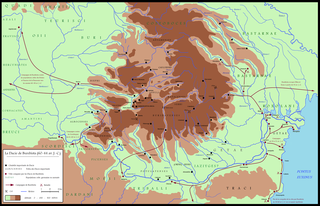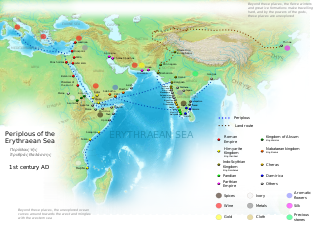
Claudius Ptolemy was an Alexandrian mathematician, astronomer, astrologer, geographer, and music theorist who wrote about a dozen scientific treatises, three of which were important to later Byzantine, Islamic, and Western European science. The first was his astronomical treatise now known as the Almagest, originally entitled Mathematical Treatise. The second is the Geography, which is a thorough discussion on maps and the geographic knowledge of the Greco-Roman world. The third is the astrological treatise in which he attempted to adapt horoscopic astrology to the Aristotelian natural philosophy of his day. This is sometimes known as the Apotelesmatika but more commonly known as the Tetrábiblos, from the Koine Greek meaning "Four Books", or by its Latin equivalent Quadripartite.

The Terme River is a short river in Samsun Province, Turkey draining into the Black Sea. Its sources are in the Pontic Mountains. It runs through the fertile Çarşamba plain to Salıpazarı, where it splits into three tributaries. The city of Terme is on the river, about 5 km from its mouth.
Sura was a city in the southern part of the area called by ancient Jewish sources Babylonia, located east of the Euphrates. It was well-known for its agricultural produce, which included grapes, wheat, and barley. It was also a major center of Torah scholarship and home of an important yeshiva—the Sura Academy—which, together with the yeshivas in Pumbedita and Nehardea, gave rise to the Babylonian Talmud.

Paropamisadae or Parapamisadae was a satrapy of the Alexandrian Empire in modern Afghanistan and Pakistan, which largely coincided with the Achaemenid province of Parupraesanna. It consisted of the districts of Sattagydia, Gandhara, and Oddiyana. Paruparaesanna is mentioned in the Akkadian language and Elamite language versions of the Behistun Inscription of Darius the Great, whereas in the Old Persian version it is called Gandāra. The entire satrapy,was subsequently ceded by Seleucus I Nicator to Chandragupta Maurya following a treaty.

Sir William Smith was an English lexicographer. He became known for his advances in the teaching of Greek and Latin in schools.

The Dictionary of Greek and Roman Geography is the last in a series of classical dictionaries edited by the English scholar William Smith (1813–1893), following A Dictionary of Greek and Roman Antiquities and the Dictionary of Greek and Roman Biography and Mythology. It was first published in 1854, and last reissued in 2005.

Singara was a strongly fortified post at the northern extremity of Mesopotamia, which for a while, as it appears from coins minted there, was occupied by the Romans as an advanced colony against the Persians. It was the camp of legio I Parthica.
The Çarşamba Plain, the ancient Themiscyra Plain, is a plain on the Black Sea coast of Turkey, formed largely of the delta of the Yeşilırmak river, but also traversed by the much smaller Terme river. It is the largest delta plain on the Black Sea coast of Turkey. It lies within the districts of Tekkeköy, Çarşamba, Terme, and Salıpazarı on the eastern part of the province of Samsun.
Zaliche or Zaliches (Ζαλίχης) was an ancient town in the late Roman province of Helenopontus.

The Coastal Mountain Range also called Jabal al-Ansariya, Jabal an-Nusayria or Jabal al-`Alawīyin is a mountain range in northwestern Syria running north–south, parallel to the coastal plain. The mountains have an average width of 32 kilometres (20 mi), and their average peak elevation is just over 1,200 metres (3,900 ft) with the highest peak, Nabi Yunis, reaching 1,562 metres (5,125 ft), east of Latakia. In the north the average height declines to 900 metres (3,000 ft), and to 600 metres (2,000 ft) in the south.

Teurisci was a Dacian tribe at the time of Ptolemy. They were originally considered a branch of the Celtic Taurisci (Noricum), who moved to Upper Tisza. However, the archaeology shows that Celts have been absorbed by Dacians, at some point creating a Celto-Dacian cultural horizon in the upper Tisza.
Adrasteia or Adrastea was the name of a region, city, and valley of the ancient Troad or of Mysia, which was watered by the Granicus River. In the eponymous city was an oracle of Apollo and Artemis. The temple had been destroyed by the time of Strabo, and the stones used to build a large altar. Parium was a port of the region.

Tapuri or Tapyri were a tribe in the Medes south of the Caspian Sea mentioned by Ptolemy and Arrian. Ctesias refers to the land of Tapuri between the two lands of Cadusii and Hyrcania.
The Aristophyli were a tribe of the district of Paropamisus, in Bactria. near the Karakorum Ranges during the Classical era.
The Ambantae were a tribe, in the district of Paropamisis in Bactria near the Hindu Kush ranges in northern Afghanistan during antiquity, and who were mentioned by Ptolemy, Curtius and Strabo. Strabo records that their lands, though very cold in winter, were fertile.
The Parietae or Paryetae, were a tribe, in the district of Paropamisis, in Bactria near the Hinu Kush ranges in northern Afghanistan during antiquity.
The Salatarae were a Bactrian tribe, who lived in the district of Paropamisis near the Hindu Kush ranges of northern Afghanistan during antiquity. They were active through Persian and Hellenistic times.

Orippo was a Roman town of Hispania Baetica, on the road from Gades to Hispalis.

Thinae, or Thina, was a capital city of the Sinae, who carried on there a large commerce in silk and woollen stuffs.
Thumata, or Thamatha, was an Arabian town of classical antiquity.











